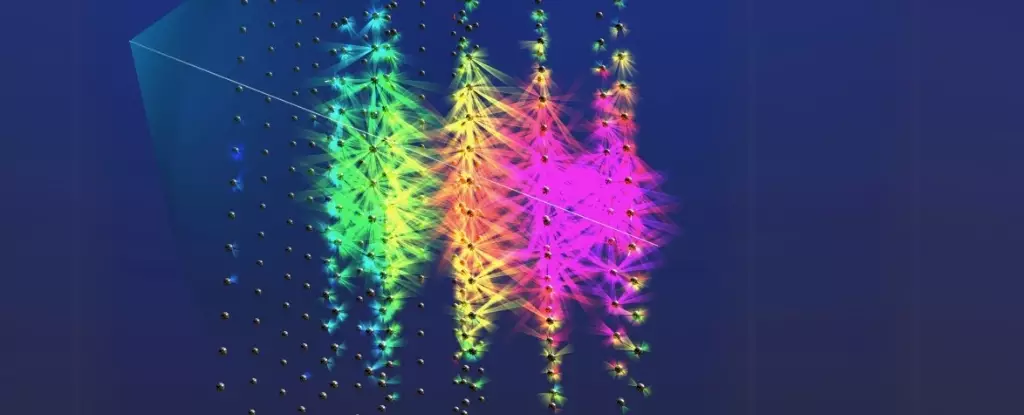On February 13, 2023, researchers achieved a significant milestone in the field of astrophysics when they detected an extraordinarily energetic neutrino emitted from the depths of space. This particle, recorded by an underwater detector stationed off the Sicilian coast, boasted an unprecedented energy level of 220 petaelectronvolts (PeV). For context, this energy surpasses the previous record of 10 PeV, positioning this new discovery as a remarkable anomaly in the study of cosmic particles. Such high-energy neutrinos prompt a plethora of questions regarding their origins and the astrophysical processes responsible for their astonishing acceleration.
Before delving into the implications of this discovery, it’s critical to understand what neutrinos are. These elementary particles are unique: they possess no electric charge and their mass is so minuscule it was once assumed to be non-existent. Neutrinos are prevalent in the universe, traversing through matter with almost no interaction. Every second, trillions of these elusive particles pass through our bodies unheeded. However, their very nature makes them exceedingly difficult to detect; capturing a neutrino necessitates vast amounts of sensitive material, like water or ice, to observe the faint flashes of light that signal their presence.
The recent neutrino event was registered by the Cubic Kilometer Neutrino Telescope (KM3NeT), which operates at a staggering depth of 3,450 meters beneath the Mediterranean Sea. Equipped with 378 modules, each housing 31 light-sensitive detectors, KM3NeT is designed to catch those rare glimpses of light emitted during neutrino interactions. During this particular event, over 28,000 photons were detected, illuminating the complexity and intensity of the neutrino’s effect within the detector volume.
High-energy neutrinos challenge our understanding of the cosmos. Given their extreme energies, only a select few astronomical phenomena are capable of propelling particles to such staggering velocities, notably supernovae and black holes. One leading suspect in this case is a blazar—a type of aspherical supermassive black hole emitting jets of radiation toward Earth. Another intriguing possibility is that this neutrino may represent the first observation of a cosmogenic neutrino, a type born from the interaction between cosmic rays and the cosmic microwave background radiation—a remnant of the Big Bang.
Traditionally, tracking the origins of such neutrinos is plagued with difficulties due to their low interaction rates with matter; thus, deducing their sources involves a combination of astronomical observations and theoretical modeling. In this particular case, researchers scrutinized four potential origin hypotheses: celestial bodies within our galaxy, external entities still nearby in the cosmos, transient events such as gamma-ray bursts, and distant extragalactic sources.
The findings, however, revealed a dearth of fitting sources except for those lying beyond our local universe. Upon isolating to the category of extragalactic objects, the focus turned predominantly toward active supermassive black holes, specifically blazars. The energy attributed to the detected neutrino suggests it originated from an exceptionally potent source.
Further investigations probed the blazar candidates within the specified region of the sky. A lineup of 12 potential blazar candidates was produced but, as expressed by the authors involved in the study, caution prevailed; the dense distribution of blazars in this cosmic arena complicates each association’s significance. No definitive links have been established, implying that subsequent studies must delve deeper to filter and authenticate any potential sources.
Moreover, the concept of cosmogenic neutrino production presents an exciting frontier in neutrino research. This theoretical framework suggests that these high-energy neutrinos could arise from cosmic rays colliding with the constant backdrop of cosmic microwave radiation or intergalactic light. Confirming such a phenomenon would offer invaluable insights into the origins of high-energy particles in the universe.
The detection of this record-breaking neutrino represents a pivotal moment in our quest to understand cosmic phenomena. With its origins shrouded in mystery, the implications for astrophysics are immense, urging scientists to expand their investigations into both localized and extragalactic sources. The exploration into neutrinos continues to be a complex yet rewarding endeavor, beckoning researchers to unravel the enigma of the universe’s most energetic particles. Comprehensive and innovative methods will soon be necessary to shed light on these remarkable treasures from the cosmos, guiding humanity closer to unveiling the mysteries of the universe itself.


Leave a Reply